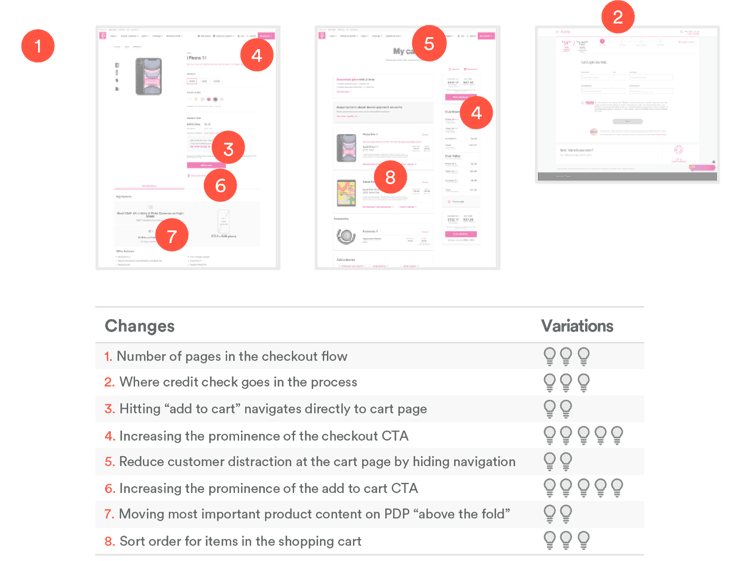The idea of being able to serve up unique customer experiences may sound incredibly attractive, but unrealistic. Unrealistic because to achieve such a vision typically means having to understand what specific experience will resonate with a visitor. This involves shifting through thousands of possible combinations. And when you’re thinking in terms of traditional testing tools this would be completely unrealistic.
Improving customer experience - it’s a scale problem
Let’s take an example where we want to optimize an online shopping experience to increase the number of successful transactions. There are many elements to consider from the number of pages in the checkout flow and where to show the call to action (CTA), to sorting items in the shopping cart and the placement of product descriptions. All these changes should also have multiple variations to represent different ideas and concepts to experiment against.
In our example, to improve customer experience, let’s assume there are 8 distinct changes, each with 2 to 5 variations, resulting in 25 total variations against the control group. To find the best customer experience requires running through a total of 62,208 possible combinations. That number alone should stop anyone in their tracks—traditionally, running a testing program for that many combinations would simply take too long, cost too much money, and would be highly unlikely to produce definitive conclusions. It would be like trying to find a needle in a haystack when the type of needle, its location, and the number of haystacks are constantly changing. Sounds impossible, doesn’t it?

Impossible is merely a matter of perspective. When approached in a different way, using a different solution, finding the needle can become entirely possible. Serving up and being able to analyze more than 62,000 unique improved customer experiences is possible when you have technology that can implement ideation at AI scale. Here’s how:
AI-driven optimization creates new growth possibilities for digital leaders
Ideation at AI scale means optimization is no longer constrained by time and traffic. When used properly, AI can process huge volumes of ideas and variations highly efficiently, delivering results in real time. It significantly broadens the horizon for digital leaders to find more ways to improve their customer experiences and hone in on those ideas that will drive growth.
With AI-driven optimization, more ideas become feasible options for optimization. It becomes possible to move beyond ‘safe’ best practice and start to explore riskier ideas and combinations that have greater potential for growth. Big and small ideas that in the testing industrial complex (Comprised of testing tools, conversion “experts,” and experimentation teams) may not hold enough statistical significance, now become a possibility for optimization. And the gains along the way quickly combine to significant revenue growth.
This empowers digital leaders to be bolder in their optimization to improve customer experience and encourages teams to innovate in finding new ways to engage customers because they’ll see immediate results. They will see what works, what doesn’t, and most importantly why.
When you’re competing for market share based on customer experience, being able to identify which ideas or combinations of ideas are generating the most conversions in real time is incredibly valuable. What’s more, having an AI smart enough to handle adding and removing ideas on the fly unlocks the potential to generate even more revenue growth.
How do you know what’s a good optimization idea?
Many companies may have unique ideas on how to improve their digital customer experience, but pinpointing their relative importance and contribution to revenue lift is practically impossible using traditional testing tools. There are too many variables and by the time the answers are delivered, they’ve often lost their relevance.
The ability to optimize ideas across the entire customer journey in real time can show exactly which changes, ideas and combination of ideas are driving conversions.
That’s how 8 changes translate into more than 62,000 unique customer experiences. When serving up ideas to consumers, the Evolv Digital Growth Optimization solution learns from each individual response. It doesn’t matter that the response may be different each time. Active learning builds on each idea until a single variation or combination of variations start to rise to the top as generating the highest number of conversions.
Converting strategy into revenue growth
Even a conservative strategy of maintaining a level of customer satisfaction and achieving customer retention requires optimization of customer experiences. Because in today’s competitive and dynamic marketplace, consumer loyalty is low. People crave value and relevance.
If a customer retention strategy isn’t tied to growth in terms of expanding the lifetime value of customers, market share will be lost to those who are innovating and creating more value through the customer experience.
The metric of customer satisfaction is only meaningful if those warm fuzzy feelings of satisfaction translate into customers clicking the buy button. That would mean they’re having a good digital experience throughout the customer journey. The ability to identify the best combination of ideas, most likely to result in a better digital experience, requires analyzing thousands of variables in different combinations and getting real-time results.
Customers don’t just want to be satisfied. They want a great experience with options. In our example, the Evolv Digital Growth Optimization solution served the best customer experience by sifting through more than 62,000 unique combinations generated from 8 optimization changes. It gives customers what they want and empowers companies to serve up more unique experiences that increase conversions and ultimately achieve revenue growth.





